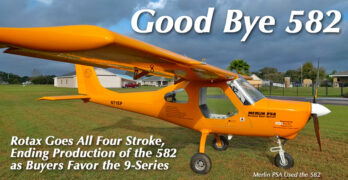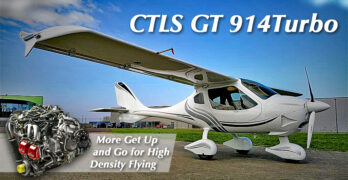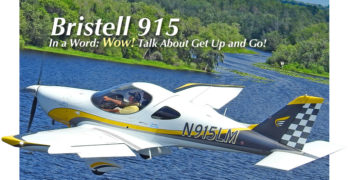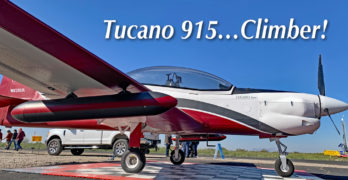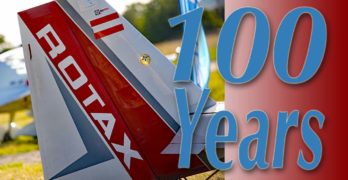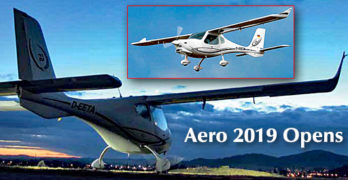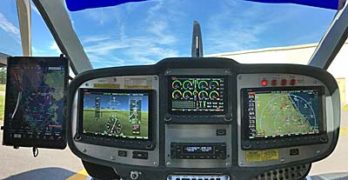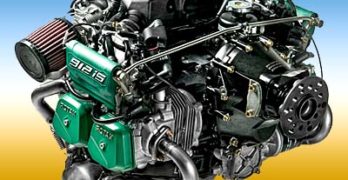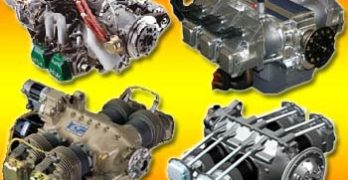As AirVenture Oshkosh 2021 starts, we have arrived at a long-awaited beginning to the world’s biggest airshow.
AirVenture Oshkosh 2021 opens Monday July 26th and I am on-site to capture all the best news I can find for light aircraft.
Regretfully, my Canada-based YouTube partner, Videoman Dave, was denied entry by Homeland Security — his occupation was “deemed not essential” — so I’ll be flying solo to write daily articles and record video.
End of an Era?
As a company news release issued just before Oshkosh shows, we have also arrived at the end of an era. Rotax announced that the Austrian engine manufacturer will cease production of their last two-stroke powerplant, the twin-cylinder, 65-horsepower 582.
Indeed, as light aviation enthusiasts prepare for the coming Mosaic regulation that will dramatically alter the landscape, a clearer dividing line is revealing itself. Many light aircraft have embraced Rotax’s four stroke engines, overwhelmingly their 9-series models including carbureted 912 ULS, fuel-injected 912iS, turbocharged 914, and the newest 915iS.
Search Results for : Rotax 915
Not finding exactly what you expected? Try our advanced search option.
Select a manufacturer to go straight to all our content about that manufacturer.
Select an aircraft model to go straight to all our content about that model.
Flight Design Introduces CTLS GT with Rotax 914 Turbo Power
Recently I interacted with a reader, someone considering a light aircraft for purchase. He inquired about the ability of ultralights or Light-Sport Aircraft to cope with high density altitude. He raised valid and worthy points but showed a certain lack of knowledge about the capabilities of light aircraft. (We are working on a more detailed article on this subject.)
Here’s the simple response: light aircraft with modern (read: powerful and efficient) engines tend to perform admirably well in high elevations, higher heat, and high humidity. If you fly almost any of these aircraft in high density conditions you already know they perform sprightly.
In contrast, I logged hundreds of Cessna 150 hours from my days as a flight instructor, and — with a similar amount of power as most LSA but also quite a few more pounds — that aircraft definitely does not perform as energetically.
So, a higher power-to-weight ratio is good, but do limits exist?
Go-Fast Mania Spreads to USA — BRM Aero’s Bristell “Speedster” with 915iS Fixed Pitch Prop
The need for speed is hard wired into humans, it seems. Even those of us who enjoy flying slow also love the idea of eating up the miles in some fast cruiser. A flight that turns a three-hour driving ordeal into a 25-minute aerial jaunt becomes a bragging right for any pilot.
Other than the pure thrill of logging a high groundspeed, going fast is only useful when you’re going somewhere. If perhaps your goal is aerial sightseeing then slow (and probably low) is the way to go. If you have to go fast, remember that old saying from auto racing: “Speed cost money; how fast do you want to go?” This equally applies to aviation.
FAA actually drew a speed line back in the early 2000s when the SP/LSA rule was being written (just as now with the LSA 2023 rule in the works). No, I don’t refer to the 120-knot speed limit we’ll discuss below.
Tucano 915 Kit Aircraft: Serious Engine, Serious Airframe, …Seriously Fun!
Copperstate is proving to be as valuable for the collection of Video Pilot Reports as Midwest and DeLand. We are reporting from the new and improved show for the second year in a row, and it’s looking good for Copperstate to earn a new, regular slot on our show calendar. Some very positive developments were discussed though it’s far too soon to write about them.
This year, attendees could hit 30,000 for the city-sponsored event (see this article for more about Copperstate linking up with Buckeye Air Fair). Still, focused shows like those above allow more time and friendlier ground operations to permit us to capture a couple VPRs a day. Pilots who attend also realize they can more thoroughly investigate a new (or new-to-them) LSA or Sport Pilot kit because the vendor is not always swamped.
At the smaller shows it’s far easier to take a demo flight.
Centennial Anniversary — 100 Years of Rotax Engines
It started with a seemingly simple product. Since long before recreational aircraft arrived, the invention that launched the Rotax brand was a “rotary axle,” a freewheeling hub that advanced the then-state-of-the-art in bicycles.
Get it? ROTary AXle. This goes way back; a patent was issued in 1906 to entrepreneur designer, Friedrich Gottschalk, only three years after Orville and Wilbur Wright (also bicycle guys) made their first flight.
Gottschalk owned a successful bicycle components factory in Dresden, Germany at the turn of the previous century. A cyclist himself, he became a full-support producer, making everything needed for bicycles: brakes, tires, seats, and more. “Anyone who considered themselves as a cyclist wanted a bicycle with a Rotax freewheel hub,” said the Austrian company.
Long, Illustrious History
“We’re celebrating 100 years of Rotax,” observed company officials. Anyone wanting to shape/explore the future needs to have a clear picture of their past.
Aero Friedrichshafen Day 1 Aircraft Highlights: Zlin Ultra 915, Flight Design F-Series, Belmont
Jetting straight from Sun ‘n Fun, we were able to arrive at Aero Friedrichshafen by noon on opening day. A quick swing around the most light-aircraft-filled halls (the “B” halls) brought some fresh surprises. Following are a few designs that caught my eye on an initial pass.
The profusion of light aircraft we don’t see in the USA — some of which will never reach the market — is one of the main reasons Aero Friedrichshafen is my favorite show in Europe. This mostly indoor fair (as Europeans call such shows) always has many ideas of interest.
Zlin Ultra with Rotax 915iS — Never one to rest Pascale Russo reintroduced his Ultra Shock from last Aero with the more powerful Rotax 915iS. Ultra Shock plays on the term “ultralight,” which means something different in Europe than in the USA (it is a reference to light aircraft quite similar to Light-Sport Aircraft).
Rotax iS Lane-Light Problems? HDX to the Rescue!
When Rotax moved their 912 iS Sport project from engineering to production, the big Austrian engine manufacturer elevated their already-immensely-popular 9-series engines to a higher level. Beside fuel injection, the company added electronic engine controls more advanced than any other in their inventory.
If you’ve flown with the iS Sport as I have you know it has terrific performance — torque was increased through an enlarged airbox along with other minor refinements — plus it gives even better fuel consumption. When flying with Aerosports‘ Jeremy Knoll at DeLand 2017, I heard that his trip from Wisconsin to Florida in the TAF Sling yielded fuel consumption rates of 2.7 gallons per hour at cruise. Man! That is some fuel efficient flying and that is part of what Rotax achieved with their iS model. They will use that technology plus more on their coming 135-horsepower 915 iS due on the market next year.
Rotax Training at Dueling Airshows
How is it that Rotax so dominates the supply of engines to light aircraft? Many reasons might be cited but one is the superlative training they offer. For 2017, the company is going even further, now offering essential training opportunities to the legions who attend airshows in both the USA and Europe.
Rotax makes high power-to-weight ratio powerplants that fit in smaller cowlings. Liquid cooling addresses the challenges of keeping motors from overheating, especially in those in tighter engine compartments. Rotax engines are modern and they keep updating them. They can produce in higher volumes than some competitors, have highly regarded quality control, and their testing facility is state-of-the-art. These reasons and more explain the estimate 75% or higher market share the Austrian company enjoys.
The Austrian engine maker said that during Sun ‘n Fun 2017 the Rotax Flying and Safety Club (RFSC) and BRP-Rotax will offer information sessions conducted by experienced RFSC instructors.
BRP-Powertrain (Rotax Aircraft Engines)
Rotax Q&A and the Engine Manufacturer Debate
It was the ninth annual LAMA Dinner at Sebring 2016. Each year, the organization has tried to do something different and this year broke new ground.
In the past LAMA has brought in speakers such as AOPA then-president Craig Fuller, EAA then-president Rod Hightower, and FAA ex-administrator, Randy Babbitt. Except for the last, they were active in their roles when they spoke but this is evidence of how things change over a fairly short time. However, two things seem not to change.
America (or at least the mainstream media) continues an infatuation with electing a new leader. Every four years — though it seems more often as the election cycles increasingly jam together — the two big political parties trot out their new candidates. The other, more relevant (to readers of this website) unchanging fact is that pilots love to hear about and talk about the engines on their aircraft.
- « Previous Page
- 1
- 2
- 3
- 4
- 5
- …
- 15
- Next Page »


